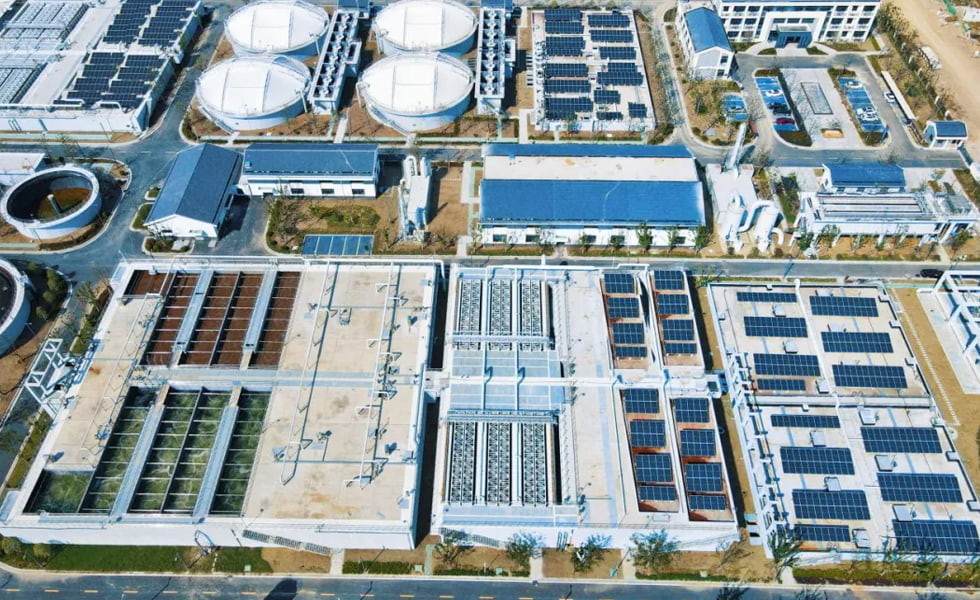
In recent years, with the acceleration of urbanization, the increase in domestic water consumption and the booming industry, the amount of sewage generated has also gradually increased. Data shows that China's sewage discharge in 2022 will be about 62.58 billion cubic meters, a year-on-year increase of 6.13%, and the number of existing sewage treatment plants in cities and counties is about 4,706.
As a high-energy-consuming enterprise, how to reduce costs, save energy and reduce consumption while ensuring that the effluent quality meets the standards has become a hot topic in the current sewage treatment field and a future development direction.
Recently, the first "photovoltaic + energy storage" power station in the sewage treatment industry in Huzhou City was debugged and put into use.
It is reported that the project is located in the New City Water Environment Treatment Center in Huzhou City and consists of a 336.6kW distributed photovoltaic system and a 300kW/645kWh energy storage system. The photovoltaic system adopts the "self-generation and self-use, surplus power to the grid" operation mode, which can provide about 313,000 kWh of clean electricity per year; the energy storage system is equipped with 3 100kW/215kWh standard liquid-cooled energy storage cabinets, adopts the "two-charge and two-discharge" operation mode, and the daily discharge capacity reaches 1150 kWh, which will realize peak shaving and valley filling on the user side, reduce electricity costs, improve power quality, and optimize the configuration of photovoltaic storage resources.
After the project is completed and put into use, it can save 88.8 tons of standard coal per year, and correspondingly reduce SO2 emissions by about 1.94 tons, NOx (in terms of NO2) emissions by about 0.657 tons, and CO2 emissions by about 254.6 tons.
Sewage treatment plant + energy storage has many benefits
You should know that due to the large area of sewage treatment plants, many equipment in the plant, 24-hour continuous operation, and long operation time, sewage treatment plants are absolutely large electricity users, so power consumption has become one of the key factors in sewage treatment plant cost control. It is reported that the electricity cost of sewage treatment plants is about 0.37-0.44 yuan/cubic sewage, accounting for 40%-50% of the total cost. In addition, sewage treatment also requires the cost of reagents, maintenance costs of facilities and equipment, overhaul costs, disinfection costs, etc.
A photovoltaic power station and energy storage system are built on the top floor of the sewage treatment station, so that the sewage treatment station uses the photovoltaic power station "self-generation and self-use, surplus power to the Internet" mode, and part of the power generation is supplied to the sewage treatment station, and part of it enters the energy storage power station for the sewage treatment station at night or on rainy days. The remaining power can also be connected to the Internet, and the income generated is used for later maintenance costs, which not only solves the sewage treatment problem, but also solves the cost worries.
In this regard, foreign markets have long been used. In 2022, Scottish Water installed the first set of solar energy + energy storage supporting facilities at a wastewater treatment plant near Perth. It is reported that the project uses 2,520 solar panels with a total output power of more than 1MW.
The project also includes a 0.8MWh all-vanadium liquid flow battery energy storage facility, consisting of four sets of all-vanadium liquid flow batteries (VFB). Developed and built by Scottish renewable energy solutions experts, the battery part was manufactured by Invinity Energy Systems.
Excellent case studies
1. In October 2017, the Napa Health Department in California deployed a 60,000m³/d sewage treatment plant. The project uses Tesla's lithium-ion battery pack to better store and release the solar energy installed in the sewage treatment plant. There are a large number of farms, vineyards, parks, cemeteries and other facilities in the area, which consume a lot of water and electricity. This battery pack is expected to save them $110,000 in electricity bills each year.
2. In September 2023, Taiyuan Water and Yingke Energy Storage jointly built the Taiyuan Water Wastewater Treatment Plant Energy Storage Power Station Project. The two parties invested in the construction of a total scale of 0.88MW/1.948MWh energy storage power station system in the Taiyuan Water Plant located on the north side of Honghe River on the east side of Guangming Road in Anyang City, Henan Province. The comprehensive electricity cost benefits are saved by using the peak-flat-valley electricity price difference in the plant area, achieving an annual discharge of about 640,000 kWh and saving about 600,000 RMB in electricity bills in the first year.
3. In December 2023, the first photovoltaic storage integrated demonstration project of the Biocity Sewage Treatment Plant was officially put into operation. The project's energy storage system uses full liquid cooling technology, lithium iron phosphate batteries, and an installed capacity of 100KW/232KWh; the photovoltaic system uses monocrystalline silicon modules, with a total installed capacity of 389.4KWp in the first phase, and self-generation and self-consumption. After the project is connected to the grid and put into operation, it is expected to generate about 300,000 kWh of "green electricity" per year.
4. Hefei Wang Xiaoying Sewage Treatment Plant covers an area of about 400 acres and was officially started in 1993. The project has an installed capacity of 10.8MW and uses monocrystalline 285W solar panels. The occupied space area is about 110,000 square meters. The grid-connected voltage level is 10kV, and the project is connected to the 10kV distribution room in the plant area at two grid-connected points. It can provide about 12 million degrees of green clean electricity per year, which is equivalent to saving 3,936 tons of standard coal, reducing carbon dioxide emissions by 11,965 tons, and reducing carbon dust emissions by 3,264 tons. The electricity generated adopts the mode of "self-generation and self-use, surplus electricity is connected to the grid", of which more than 90% can be consumed on-site by sewage treatment plants.
